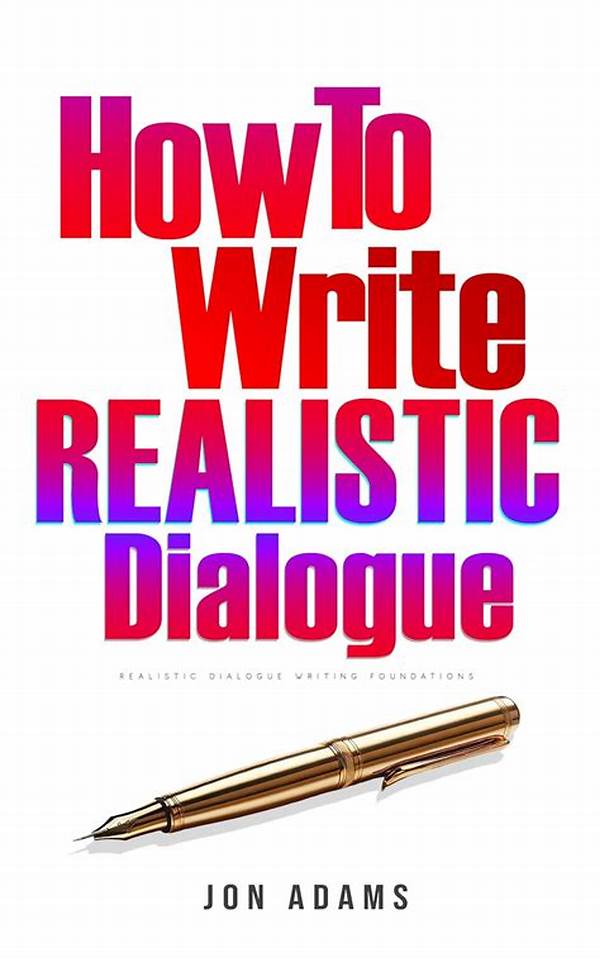Crafting dialogue that resonates with readers and feels genuine is an essential skill for any writer. Realistic dialogue can breathe life into characters and immersion into your story. Despite its importance, it remains one of the trickiest aspects of writing to master.
Understanding Realistic Dialogue
To grasp how to write realistic dialogue, one must first understand that realistic doesn’t always mean grammatically correct or eloquent. In everyday speech, people use contractions, colloquialisms, and often interrupt each other. Capturing this organic flow requires an astute ear for how people actually talk. Writing dialogue involves not just conveying information, but also capturing the subtext and the natural rhythms of conversation. To create authentic exchanges, it’s critical to pay attention to cadence, tone, and context. The goal is to mirror real conversations in a way that serves your narrative and develops your characters. This requires practice, patience, and perhaps a good bit of eavesdropping in cafes or public places.
To effectively learn how to write realistic dialogue, read aloud what you’ve written. This oral exercise helps identify awkward phrases or unnatural stiltedness. Real dialogue isn’t always pretty or perfect; it’s full of starts, stops, and sometimes an unexpected word choice. The challenge lies in using these imperfections to enhance realism while advancing the storyline or deepening character development.
Elements of Realistic Dialogue
1. Listen to Real Conversations: Immerse yourself in real-world dialogues to understand how to write realistic dialogue. Notice rhythm, interruptions, and the natural ebb and flow.
2. Capture Subtext: Focus on what’s implied rather than what’s directly stated. Authentic dialogue reflects underlying emotions and tensions.
3. Character Voice: Ensure each character has a distinct way of speaking. This uniqueness is crucial in how to write realistic dialogue, giving depth and authenticity.
4. Contractions and Colloquialisms: Use these to mimic everyday speech patterns. It’s essential in how to write realistic dialogue.
5. Experiment and Edit: Writing and refining are iterative processes. Your first draft might not sound perfect, but editing helps in honing how to write realistic dialogue.
Dialogue and Character Development
When exploring how to write realistic dialogue, it’s important to remember that it serves not just to convey information, but to develop characters. Dialogue is an external manifestation of a character’s inner world. It is a reflection of their personality, background, and growth. Through engaging conversations, readers learn about the character’s aspirations, fears, and quirks without needing lengthy exposition. A well-crafted dialogue can reveal a character’s most intimate thoughts, as well as their external motivations.
The task of how to write realistic dialogue also involves balancing what is said with what is left unsaid. Mastery in this area involves carefully placing pauses, silences, and the weight of words to evoke the right emotional response from the reader. Conversations can shift the power dynamics, create tension, or provide comic relief, making them an indispensable tool in storytelling.
Common Pitfalls in Writing Dialogue
Perfecting the craft of how to write realistic dialogue can be fraught with challenges. Often, writers fall into the trap of making their dialogues either too mundane or overly dramatic. While everyday exchanges can be boring to read, excessive melodrama can seem contrived. Writers must strike a balance that aligns with a character’s personality and advances the plot. Another common issue is using dialogue as an information dump. Realistic conversations rarely involve detailed factual exchanges.
Another aspect to consider when learning how to write realistic dialogue is the pacing. Poor pacing can disrupt the flow of a scene, making it seem either rushed or dragged out. This requires a keen sense of timing and well-placed beats within the dialogue. Implement subtle changes in tone and language to match escalating emotional states or tension between characters, ensuring that the dialogue feels dynamic and reflective of real interactions.
Techniques to Improve Dialogue Writing
Engaging in writing workshops or critiques can be invaluable in learning how to write realistic dialogue. Such environments offer a fresh perspective on an individual’s work and foster constructive feedback. Observational exercises, where one notes down interesting snippets of conversation in daily life, can also provide inspiration. Practically, character interviews can be a useful exercise. This involves writing dialogues between characters about mundane topics, which can unexpectedly reveal rich personality facets. Finally, block out time for reading plays or screenplays. These mediums sharply focus on dialogue and character interaction, providing rich examples of how to write realistic dialogue.
Immersive Dialogue Examples
To better illustrate how to write realistic dialogue, consider novels where dialogue drives the plot or defines characters. For instance, authors like Elmore Leonard or Raymond Carver have a knack for punchy, lifelike dialogue that conveys more between the lines. Studying works by such writers can enlighten strategies for embedding subtext and resonance in character exchanges.
Engaging with diverse styles and genres broadens one’s understanding of crafting dialogue. Whether it is a gripping thriller, a poignant drama, or a light-hearted comedy, diverse reading ensures exposure to a range of authentic conversational techniques. By analyzing and adapting these styles, writers can refine their skills in how to write realistic dialogue, creating believable and memorable interactions in their narratives.
Summary of Crafting Authentic Dialogue
In summary, the art of how to write realistic dialogue hinges on understanding human interaction and applying this knowledge to writing. The goal is to evoke naturalness without sacrificing clarity or narrative progress. Practicing the art of listening, embracing imperfections in speech, and focusing on character individuality are critical components.
Writers striving to master how to write realistic dialogue must continue learning, practicing, and experimenting. A writer’s toolbox should always include keen observational skills and adaptability to tweak dialogues until they resonate with truth and authenticity. In the complex dance of dialogue, a balance between what is said and what is unsaid transforms ordinary words into a powerful storytelling tool.
